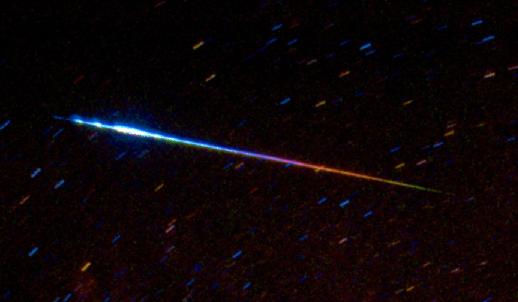
|
Credit & Copyright: S.
Kohle & B. Koch
(Astron. I., U. Bonn)
Explanation:
Tonight the
Perseid
Meteor Shower reaches its maximum. Grains of rocky ice will
streak across the sky as they evaporate during entry into
Earth's
atmosphere. These ice chips were shed from
Comet Swift-Tuttle. The
Perseids result from the annual
crossing of the Earth through Comet Swift-Tuttle's orbit. The
Perseids
are typically the most active
meteor shower of the year.
In a clear dark sky, an observer might see a meteor a minute.
Pictured above is a Perseid
meteor
from 1993. The colors are representative but digitally enhanced. As the
meteor streaked across the night sky,
different excited atoms emitted different colors of light.
The origin of the green tinge visible at the right is currently unknown,
however, and might result from
oxygen
in Earth's atmosphere. Perseid meteors can best be seen from a relaxing position, away from lights.
|
January February March April May June July August September October November December |
| ||||||||||||||||||||||||||||||||||||||||||||||||
NASA Web Site Statements, Warnings, and Disclaimers
NASA Official: Jay Norris. Specific rights apply.
A service of: LHEA at NASA / GSFC
& Michigan Tech. U.
Based on Astronomy Picture
Of the Day
Publications with keywords: meteor
Publications with words: meteor
See also:
- APOD: 2025 August 25 Á The Meteor and the Star Cluster
- APOD: 2025 August 6 Á Meteor before Galaxy
- APOD: 2024 November 27 Á The Meteor and the Comet
- Meteor over the Bay of Naples
- Fireball over Iceland
- APOD: 2023 August 23 Á The Meteor and the Galaxy
- APOD: 2023 July 16 Á Meteor and Milky Way over the Alps
